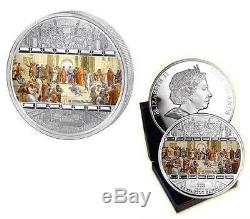Cook Islands 2008 20$ Masterpieces of Art School of Athens 3oz Silver Coin


COIN WITH 16 SWAROVSKi CRYSTALS INSERTED. The title School of Athens is an old tour-books invention, which tends to obscure the paintings immediate context and meaning.
It is actually one of a group on the four walls of the Stanza (those on either side centrally interrupted by windows) that depict distinct themes of knowledge. Each theme is identified above by a separate tondo containing a majestic female figure seated in the clouds, with putti bearing the phrases: Seek Knowledge of Causes, Divine Inspiration, Knowledge of Things Divine (Disputà), To Each What Is Due. Accordingly, the figures on the walls below exemplify Philosophy, Poetry (including Music), Theology, Law. The School is therefore actually Philosophy, and its overhead tondo-label, Causarum Cognitio tells us what kind, as it appears to echo Aristotles emphasis on wisdom as knowing why, hence knowing the causes, in Metaphysics Book I and Physics Book II. Indeed, Aristotle appears to be the central figure in the scene below. However all the philosophers depicted sought to understand through knowledge of first causes. Many lived before Plato and Aristotle, hardly a third were Athenians, and the architecture is Roman, not Greek. Commentators have suggested that nearly every great Greek philosopher can be found within the painting, but determining which are depicted is difficult, since Raphael made no designations outside possible likenesses, and no contemporary documents explain the painting. Compounding the problem, Raphael had to invent a system of iconography to allude to various philosophers for whom there were no traditional visual types. For example, while the Socrates figure is immediately recognizable from Classical busts, the alleged Epicurus is far removed from the standard type for that philosopher. Nevertheless, there is widespread agreement on the identity of certain figures within the painting. Aside from the identities of the philosophers shown, many aspects of the fresco have been interpreted, but few such interpretations are generally accepted among scholars. The popular idea that the rhetorical gestures of Plato and Aristotle are kinds of pointing (to the heavens, and down to earth) is a likely reading. However Platos Timaeus which is the book Raphael places in his hand was a sophisticated treatment of space, time and change, including the Earth, which guided mathematical sciences for over a millennium.Aristotle, with his four elements theory, held that all change on Earth was owing to the motions of the heavens. In the painting Aristotle carries his Ethics, which he denied could be a scientific study. It is not established how much the young Raphael knew of ancient philosophy, what guidance he might have had from people such as Bramante, or what detailed program may have been dictated by the Papal sponsor.
Heinrich Wölfflin observed that it is quite wrong to attempt interpretations of the School of Athens as an esoteric treatise The all-important thing was the artistic motive which expressed a physical or spiritual state, and the name of the person was a matter of indifference in Raphaels time. What is evident is Raphaels artistry in orchestrating a beautiful space, continuous with that of viewers in the Stanza, in which a great variety of human figures, each one expressing mental states by physical actions, interact, and are grouped in a polyphony unlike anything in earlier art, in the ongoing dialogue of Philosophy. Our shippment is insured, inkl. Return item must be sent within 14 days after it has been received. Kmk-coins ist a young merchant/distributor of selected commemorative- and collectional-coins.
We garantee the authenticity of the coins we sell. We will always do our best to please our customers. The item "Cook Islands 2008 20$ Masterpieces of Art School of Athens 3oz Silver Coin" is in sale since Tuesday, October 18, 2016. This item is in the category "Coins & Paper Money\Coins\ World\Commemorative". The seller is "kmk-coins" and is located in Berlin. This item can be shipped worldwide.
